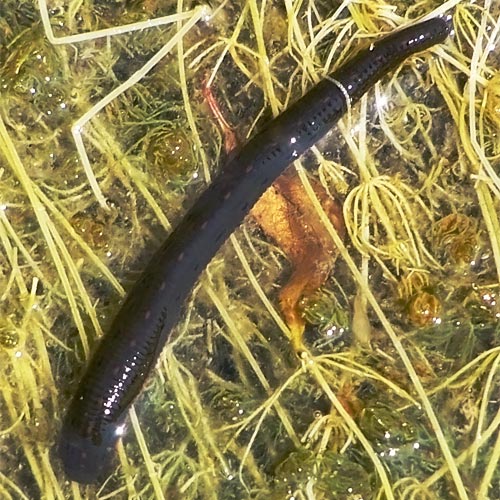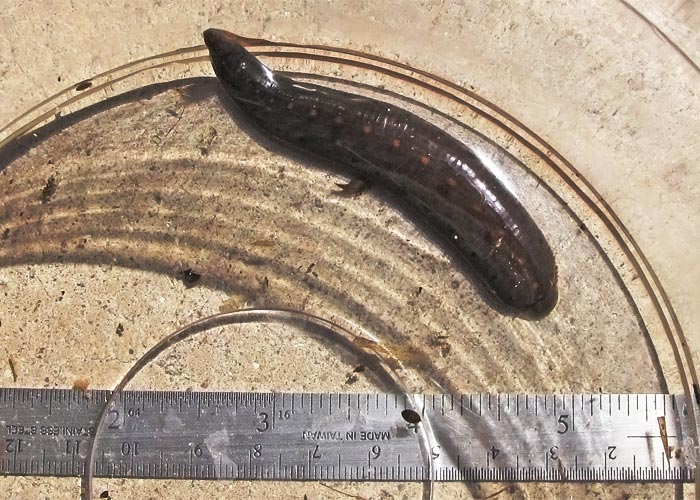Salutations, BugFans,
OK, we’re having an “African Queen” moment (a great movie, in case you youngsters haven’t seen it. People may not recall the characters’ names or whether he stopped drinking or she started or whether the boat went over Victoria Falls or even who won WWI, but they can ALWAYS describe the leech scene).
Recently, when the Bug Lady was nosing around the Bentley Pond at Riveredge Nature Center, she saw lots of leeches swimming through the pond weeds. Leeches like quiet, sun-warmed ponds with plant debris on the bottom, and, because you thought it was safe to go back into the water, a healthy leech habitat may support as many as 7,000 leeches per square meter (so it’s a good thing we don’t use the metric system here).
Leeches
Leeches are in the phylum Annelida (segmented worms) (in the case of leeches, that’s 34 segments. The Bug Lady loves trivia—one of her offspring calls her an “esoterrorist”). There are eyespots along the dorsal (top) side of the first few segments. Unlike their mostly terrestrial cousins the earthworms, leeches are flattened in cross section. Their bodies are soft but very “buff” and muscular. Sometimes they travel along on the underside of the surface film, like up-side-down inchworms, hanging on to that sticky, top layer of water molecules with suckers located at each end. Many are graceful swimmers, with undulating locomotion. The “business end,” the mouth, is located within the front sucker. When they bite, they inject both a painkiller and an anticoagulant and may suck out five times their weight in blood. Leeches are making a come-back in medical practice, especially in reattachment surgeries, and modern science has confirmed beneficial, long-term effects of leech therapy. “Leech” was once a synonym for “Physician” because of the leeches that doctors used in their practice.
Although some species are scavengers, most leeches suck blood, often specializing in one group, like invertebrates or frogs or fish. This guy/gal is one of the Macrobdella leeches, which feed on the blood of vertebrates (plus the odd frog egg or aquatic insect larva), and which can grow up to be at least 6” long. Like sharks, they zero in on prey that splashes around in/disturbs the water (pond-swimmers take note). The Horse leech lives in watering troughs, awaiting thirsty livestock. Leeches that feed on small invertebrates may swallow their prey whole, extract the bodily fluids, and spit out the crunchy-bits. Some species can wait a year or more between feedings.
Leeches are hermaphroditic (having characteristics of both genders). Each individual has both eggs and sperm, and when they “exchange bodily fluids” (through openings on the 11th and 12th segments) they fertilize each other. See how delicately the Bug Lady phrased that? Some leech species put their eggs in a sac and leave the sac in a damp area; others attach the sac to their ventral (underneath) side and carry it around until the eggs hatch. These little suckers stay attached to dear old Dad/Mom and eat the remains of the sac before swimming away.
On the positive side of the coin, they are eaten by fish, salamanders and birds as well as carnivorous aquatic insect larvae. On the negative side—well, they’re leeches, with all of the baggage (ours) that comes with that.
One book advises collectors that because many species are alert to disturbances in the water, just walking into a pond will attract them and they will attach to your boots, or whatever…. You can take them home and name them and feed them ground beef or snail meat and they may grace your aquarium for a decade or more.
Sure thing!
The Bug Lady

